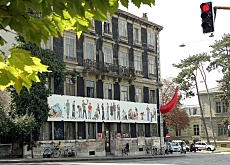Historic squat battles to avoid extinction

One of Geneva's oldest squats, the Rhino, is heading for a showdown with the canton's justice authorities over plans to evict its 70 residents.
Geneva’s chief prosecutor has ordered them to leave by November 22, but the residents are refusing to go quietly.
The Rhino, which groups three buildings near Geneva University Hospital, is one of the last remaining bastions of a movement that saw the city become Europe’s squatting capital a decade ago.
But the squat, which has successfully fought off previous eviction attempts over the past 17 years, is now battling for survival.
A last-ditch cantonal initiative signed by almost 12,000 people was lodged in August, urging the local authority to make a compulsory purchase order and lease the buildings back to the residents.
A demonstration is due to take place on Saturday, highlighting the precarious position in which the Rhino now finds itself.
“There is a risk that we will reach the 22nd and nothing will have changed,” resident Maurice Pier told swissinfo.
“The authorities and the owners should not underestimate the frustration we have been feeling and that people have expressed to us around the city. We are not just any squat.”
Housing crisis
Squatters first occupied the three abandoned buildings in 1988 at a time of rampant property speculation and a housing crisis in the city.
Since then the Rhino, with its trademark giant horn, has evolved to become a fixture on the city’s alternative cultural scene, with its own bistro and centre for experimental music.
But the arrival of a new owner in 1998 saw the residents come under renewed pressure to leave. Planning permission to renovate the buildings was granted in 2004, and this led to last month’s eviction order.
Pier says negotiations with the current owner have gone nowhere, leaving a compulsory purchase order by the canton as the last resort.
“We have always been prepared to pay rent since the beginning. The goal has been to have a communal lease, but the offers that have been made to us have been crazy,” he said.
“We want these buildings, and other buildings as well, to be kept out of the housing market and to be used as housing coops, with low-cost rent.”
Trouble ahead
Jean Rossiaud, a sociologist at Geneva University, believes that unless a solution can be found within the next couple of weeks, things could get nasty.
He says the Rhino remains a potent symbol of the stand taken against property speculators, empty buildings, and high rents back in the late 1980s, which united the political left.
By the mid-1990s Geneva was the most squatted city in Europe per head of population, with more than 140 buildings occupied and 1,000 squatters.
At the time the authorities were prepared to turn a blind eye because there were almost 5,000 empty properties in the city.
It was only after the arrival of new owners with the financial means to renovate buildings that evictions started taking place.
“But certain squats like the Rhino have always been seen by the people of Geneva as more than just occupied buildings. They are viewed as symbols of the fight against property speculation,” warned Rossiaud.
“There is an aura that surrounds the Rhino, and I think there will be clashes if the authorities try to evict the residents. There will be big demonstrations, the residents will barricade themselves in and some politicians might try to join them. A lot depends on whether the prosecutor and the political right want a showdown.”
Of one thing Rossiaud is certain, though: whether the Rhino falls or is “institutionalised” by the canton, the affair marks the final chapter in the history of city’s squat movement.
End of the line
Geneva’s chief prosecutor Daniel Zappelli told swissinfo that there were only two ways in which the eviction order could now be averted.
One is for the residents to leave of their own accord; the second is if an agreement is reached between the residents and the buildings’ owner.
“If there is no agreement for a postponement of the eviction, there won’t be any change,” he said. “Then if they don’t move out of their own free will, they will be moved out by force.”
Zappelli said moves by Rhino supporters to obtain a compulsory purchase order would not result in a stay of execution.
He added that once the current “illegal tenants” were evicted, the buildings would be renovated to create large, low-cost flats of which there is a chronic shortage in the city.
“If I have to choose between an illegal occupation and the creation of new apartments, there is no hesitation as far as I am concerned.”
swissinfo, Adam Beaumont in Geneva
According to sociologist Jean Rossiaud, the first wave of squats in the city came at the end of the 1970s with the occupation of parts of Les Grottes district, behind the main railway station. Plans to move its working-class residents to the outskirts were the catalyst.
The Rhino figured among the second wave in the 1980s, which came as a reaction to property speculation and a housing crisis.
A third wave of squats occurred in the mid-1990s, partially driven by the huge number of vacant properties in Geneva – 4,877 in 1996.

In compliance with the JTI standards
More: SWI swissinfo.ch certified by the Journalism Trust Initiative










You can find an overview of ongoing debates with our journalists here . Please join us!
If you want to start a conversation about a topic raised in this article or want to report factual errors, email us at english@swissinfo.ch.